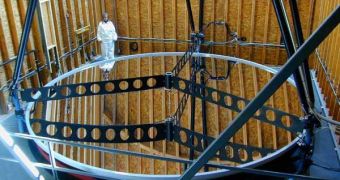Traditional glass mirrors used in telescope manufacturing are very expensive and extremely hard to build, not to mention that they weigh a 'ton' and are incredibly difficult to maneuver. And then there's always the risk that once completed, they may not turn out to be perfect for the job (remember Hubble?). Simply put, they're just a big pain in the back. All this can become a thing of the past in as little as one year, when glass mirrors will be replaced with liquid ones, cheap, light weight and easy to manufacture and maneuver.
The idea is that the surface of a pool of mercury, or any other liquid reflective compound, spun in a container, takes a parabolical shape, similar to that of the reflective surface of a glass mirror. Such a liquid mirror will equip the world's first dedicated astronomical observatory in 2009, the International Liquid Mirror Telescope, an international project supported by Belgium and Canada that will place a 4 meter liquid mirror on top of a mountain range in northern India.
Yet another collaboration of this kind is set to build a liquid mirror telescope for astronomical observations with a diameter of 8 meters, while others are even considering putting such a device on the surface of the Moon. A liquid mirror could cost up to ten times less than a glass mirror of the same size.
The only problem of the concept is that the telescope using a liquid mirror can only be directed upwards. Nonetheless, an 8 meter liquid mirror telescope placed just at the right place could view up to a billion galaxies as the planet spins around its axis and detect larger numbers of supernovae or study the properties of dark energy.
Another ground based telescope, the Advanced Liquid-mirror Probe of Astrophysics, Cosmology and Asteroids, or ALPACA for short, with a liquid mirror measuring 8 meters across has been proposed for construction by Arlin Crotts from the Columbia University. By contrast, the telescope proposed for construction on the Moon could be at least 20 to 100 meters across, and could study the early universe and the formation of the galaxies.
For now however, a 2 meter telescope should do just fine for a first step.
In order to disable some of the limitations experienced with liquid mirror, Ermanno Borra from the Laval University along with his colleagues are working on developing high reflective viscous liquid that would allow the liquid mirror to tilt at angles as high as 30 degrees from vertical. Glass mirrors are simply not a choice anymore when it comes to bigger and better telescopes, but liquid mirror may offer the alternative.
"If you go back to the beginning of the 20th century, it was mostly the refracting lens-based telescopes that were used and it took some time for glass mirrors to take over. My feeling is that we're going to see the same thing with liquid mirrors", said Borra.

 14 DAY TRIAL //
14 DAY TRIAL //